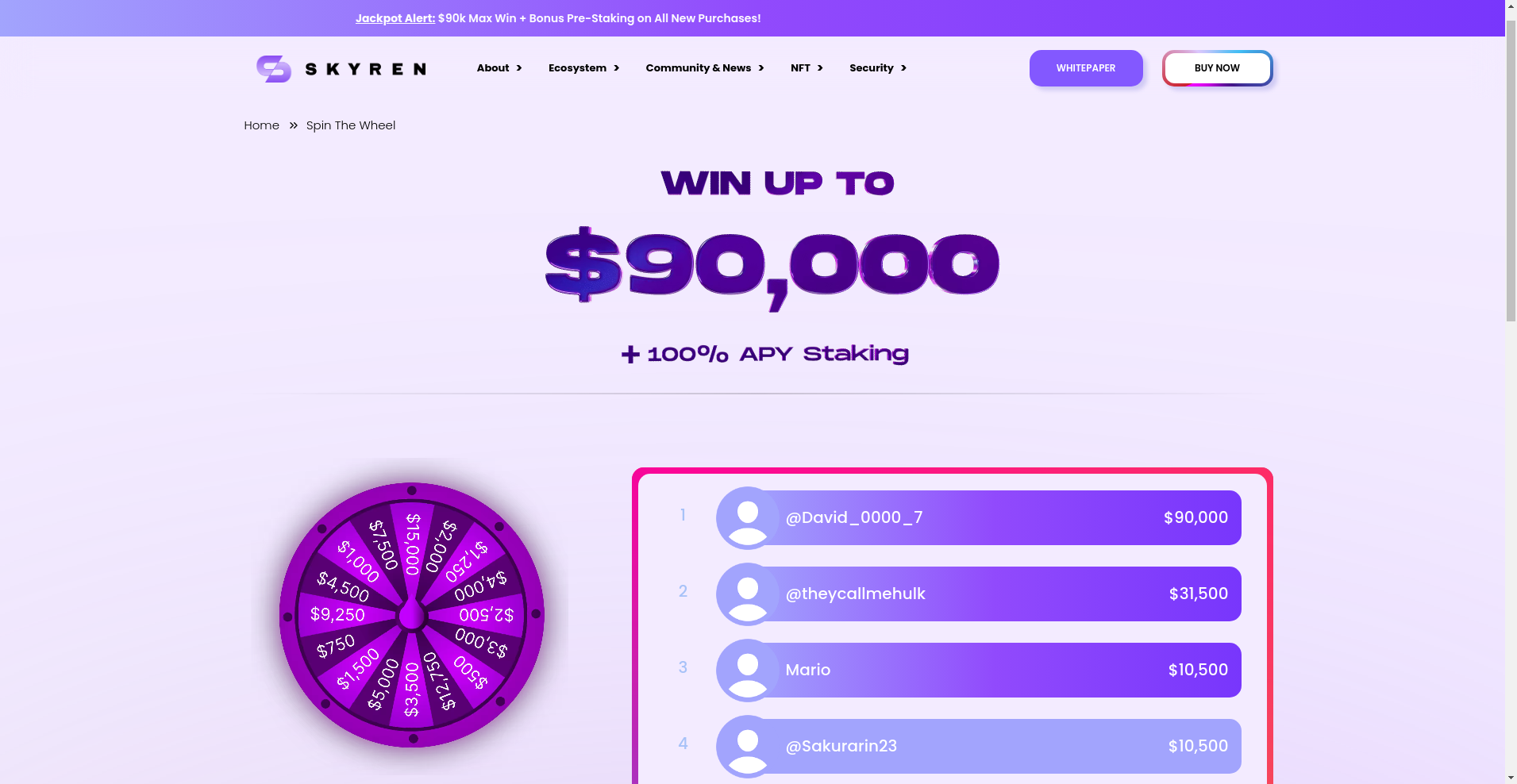Skyren ($SKYRN) Review: A Data-Driven Look at Its Legitimacy, Risks, and Potential

What Is Skyren: An Introduction
Skyren is billed as an innovative DeFi ecosystem centered around its native token, $SKYRN. The project aims to combine automated airdrop collection, community-driven governance, and passive income opportunities. Using advanced algorithms, Skyren scans multiple blockchains to identify lucrative airdrop campaigns and automatically participates on behalf of its users, claiming a unique position in the crowded DeFi space.
This review provides an impartial, evidence-based assessment of Skyren’s strengths and weaknesses, focusing on its technological integrity, legal soundness, community credibility, security measures, and economic sustainability. As always, prospective investors should weigh the project’s opportunities against identified risks before considering any involvement.

Team and Roadmap Evaluation
Based on publicly available information, Skyren's team details are limited. The audit report references a contract audit conducted by Cyberscope, but there is no clear disclosure of team members, their backgrounds, or prior experience. The project maintains a community Telegram with nearly 4,000 members, yet faces typical transparency gaps common in early-stage DeFi ventures.
Skyren’s roadmap outlines multiple phases, aiming for broader ecosystem integrations, cross-chain functionality, and governance features:
- Q1 2025: Initial launch, whitepaper release, security audits, community engagement, and the onset of the native SKYRN token presale.
- Q2 2025: Cross-chain compatibility, partnerships, DAO launch, and security audits, with ongoing community bounties.
- Q3-Q4 2025: Further DeFi integrations, governance onboarding, UI refinements, and establishing Skyren as a leading airdrop DAO.
While the plan appears comprehensive, the success hinges on execution, strategic partnerships, and continuous security audits. The lack of concrete team verification raises questions about long-term core contributors and governance decentralization capabilities.

Assessing the Security and Trustworthiness
The security analysis relies heavily on a single Cyberscope audit conducted in December 2024, covering the token contract deployed on the Polygon network. Notably, the audit received a high-security score of 85, indicating a generally solid codebase. Key findings include:
- High Criticality Vulnerability: Present in the token contract, which warrants careful monitoring and possibly further audits.
- Audit Scope: Focused primarily on token functionality, with no explicit mention of broader protocol security audits or ongoing bug bounty programs.
- Decentralization & Governance: Given the limited audit scope, the governance mechanisms' safety—especially upgradeability and on-chain voting—remain moderately uncertain.
- Transparency: Open-source smart contracts and accessible audit reports bolster trust, but potential vulnerabilities in a complex ecosystem require ongoing security practices.
Although the high audit score suggests a baseline level of security, the critical vulnerability and lack of multiple audit sources introduce some risk, particularly if what is audited is limited in scope. Investors must consider that in DeFi, smart contract risks are inherent and often only mitigated through continuous testing and community vigilance.

A Breakdown of Skyren Tokenomics
Skyren’s tokenomics aims to facilitate mass adoption within a vibrant DeFi ecosystem. The total supply is set at 190 million SKYRN tokens. The distribution is heavily presale-driven, with 75% allocated to early investors, highlighting a focus on rapid ecosystem bootstrap:
- Total Supply: 190,000,000 SKYRN
- Presale: 75% (142.5 million SKYRN)
- Staking & Rewards: 12.5% (23.75 million SKYRN), with automatic staking for presale buyers
- Liquidity Pool (DEX and CEX): 5% (9.5 million SKYRN)
- Marketing & Adoption: 3% (5.7 million SKYRN)
- Airdrops and Contributors: 2.5% (4.75 million SKYRN)
- Vesting & Unlock Schedules: Not explicitly detailed in the provided documents, raising questions about inflation control and long-term utility.
The heavy presale allocation emphasizes early support but introduces potential risks related to control and centralization of supply. The high initial token supply, coupled with a large presale share, can create inflationary pressures if not managed through vesting and utility-driven demand. The project promises staking rewards up to 76% APY on presale tokens, designed to incentivize early holders.
While the economic model seeks to promote network growth and user engagement, the reliance on presale sales might risk market dumping if post-launch liquidity is not sufficient or if early investors seek quick exits, impacting price stability.
Assessing Skyren's Development and Ecosystem Activity
From the available data, Skyren’s activity appears primarily developmental with ongoing efforts to build a comprehensive ecosystem. The project has released its whitepaper, conducted its first security audit, and launched initial token sales. Its ecosystem components include a governance portal, NFT marketplace, staking pools, and cross-chain bridges, with planned iterations for expanded DeFi integrations and community governance tools.
However, concrete signs of active user adoption or transaction volume are absent, likely due to the project's early stage. The website indicates upcoming features ("Available Soon") and promotional campaigns such as "Win $90k in Spin-The-Wheel," designed to attract community participation. Without verifiable usage metrics, it remains uncertain whether development efforts translate into real-world engagement. Understanding automated airdrop collection strategies will be key to its user acquisition.
Genuine progress can be gauged by community activity, community-led proposals, and the deployment of ecosystem features. Although the project has foundational elements, the lack of transparent, on-chain activity data warrants cautious interpretation.
Review of Terms and Conditions
Based on the available documentation, Skyren maintains standard crypto project disclosures. The whitepaper and website contain necessary legal notifications, including caveats about unregulated status, market volatility, and tax considerations. No abnormal or potentially risky clauses stand out, such as punitive lock-ins or unfettered upgrade rights that could harm investor rights. The legal disclaimers are crucial for understanding the inherent risks.
The presence of multiple legal pages (Terms of Use, Privacy Policy, Cookies Policy) indicates a baseline compliance effort. However, as with many projects, specific jurisdictional disclaimers or detailed investor protections are lacking. The project’s reliance on code and a limited audit scope emphasizes that in DeFi, the true legal and security risks are embedded within smart contract integrity and governance decentralization rather than contractual language alone.
Final Analysis: The Investment Case for Skyren
Skyren presents itself as a multi-faceted DeFi project with innovative features like automated airdrop farming, community governance, and high-yield staking. Its strong emphasis on transparency—through audits and open-source contracts—combined with ambitious roadmap goals, enhances its trustworthiness. The integration with Polygon promises efficient transactions and broader DeFi connectivity.
However, certain red flags and inherent risks temper its viability as a long-term contender:
- Limited team transparency: No verified team members’ identities or backgrounds are publicly disclosed, which is atypical for mature DeFi projects.
- Security scope constraints: The audit conducted was primarily for token functionality, with no comprehensive ecosystem audit or bug bounty programs confirmed. An article on the importance of multi-chain security audits would highlight this weakness.
- Supply concentration: High presale token allocation could lead to price volatility and market manipulation.
- Real-world adoption: Absence of clear usage metrics or on-chain activity makes validation of progress challenging.
- Promotion-Driven Engagement: Heavy marketing signals, such as "Win $90k," may attract speculative investors more than long-term ecosystem builders.
In conclusion, Skyren exemplifies a compelling yet risky DeFi venture. Its innovative approach and promising security posture are balanced by transparency gaps and the typical smart contract risks endemic to early-stage projects. Prospective investors should perform thorough due diligence, monitor ongoing security audits, and consider the project’s capacity to sustain demand beyond promotional hype.
While this review is an impartial analysis based on available data, the decision to engage with Skyren ultimately depends on individual risk tolerance, understanding of DeFi mechanics, and confidence in the project’s roadmap and security posture.

Jessica Taylor
NFT Market Data Scientist
Data scientist specializing in the NFT market. I analyze on-chain data to detect wash trading, bot activity, and other manipulations that are invisible to the naked eye.
Similar Projects
-
Furucombo
Furucombo Review: Scam or Legit Crypto? In-Depth Analysis
-
Bark
Bark ($BARK) Review: Risks, Security & Project Analysis
-
Useless Coin
Crypto Project Review & Scam Checker: Useless Coin - Is It a Scam?
-
Quarashi Network
Comprehensive Review of Quarashi Network: Crypto Project Scam Checker and Investment Analysis
-
ASH TOKEN
Comprehensive Review of ASH TOKEN - Crypto Project Scam Checker & Risk Analysis